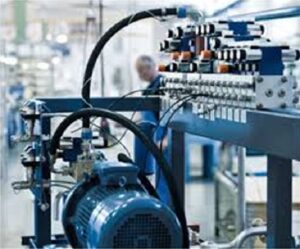Pneumatics and Hydraulics Similarities Differences and FAQs
Pneumatics and Hydraulics
In this article we will provide you the Pneumatics and Hydraulics Similarities Differences and FAQs.

What does pneumatic mean?
Pneumatics is the study of gases under pressure and the technology related to them. It involves the use of compressed gas to transfer mechanical energy, as well as the use of valves, sensors, actuators and other pneumatic equipment to control industrial processes. The dynamic nature of compressed gas allows large amounts of energy to be handled in a small space. This quality makes pneumatics widely used in all kinds of modern industrial machinery from light tools to multifunctional robots. Pneumatic engineering is also essential in advanced aerospace and military systems due to its high reliability and low cost.
What does hydraulics mean?
Hydraulics is the field of engineering that studies the effects and applications of water pressure . This branch of knowledge is used to design, build, and maintain mechanical equipment such as pipelines, pumps, hydroelectric systems, and other related devices. Most of the work involves Each type of memory has its own operation, although all of them cooperate to carry out a complete memorization process. This is Each type of memory has its own operation, although all of them cooperate to carry out a complete memorization process. This is complex mathematical calculations to produce an exact result based on well-defined physical principles. Hydraulic engineers can help maximize energy efficiency by developing new efficient mechanisms or finding innovative ways to address existing problems. Additionally, they are involved in research on hydraulic technologies and environmental measures that can further improve our quality of life.
Similarities between pneumatics and hydraulics
The similarities between pneumatics and hydraulics are several. Both are found within mechanics, since they are related to the movement and control of machinery. In both techniques, fluids, such as air or oil in this case, serve to transmit energy through displacement. As in a pneumatic system, hydraulic forces depend on fluid pressure; This is directly proportional to the internal diameter of the tube, loss due to friction and inversely proportional to the total number of turns given by the liquid path. Additionally, both types allow work to be done using a device called a cylinder.

Differences between pneumatics and hydraulics
Below are ten major differences between pneumatics and hydraulics.
1-Speed and power
Hydraulic systems achieve very high powers, while pneumatic systems develop slightly lower powers.
However, pneumatic systems are capable of reaching much higher speeds than hydraulic ones.
2-Longevity
Longevity is greater in pneumatic systems , as long as they are properly cared for and maintained. However, the tires, although they have a more moderate life, have more capacity in terms of spare parts, so their repair is quite feasible.
3-Environmental factors
Hydraulic systems are more polluting if they lose fluids, while pneumatic systems pollute acoustically , since they produce quite loud noises.
4-Maintenance
In this case, it is the tires that win, since they have much lower maintenance costs than hydraulic ones. Hydraulic systems are more expensive to maintain .
5-Purchase price
Hydraulic machines are much more expensive than pneumatic ones.
6-Open or closed system
The hydraulic system works on the principle of Pascal’s law which says that the pressure in an enclosed fluid is uniform in all directions, however, the pneumatic system is an open loop system .
7-Pressure
As oil is incompressible it can be pressurized to a very high pressure, however in pneumatic systems air is compressible and therefore the air can be pressurized to a lower pressure.
8-Working fluid
In the hydraulic system, the working fluid is hydraulic oil , a non-compressible fluid that plays a fundamental role for the proper functioning of hydraulic systems, however in pneumatic systems the working fluid is air.
9-Precision
The precision of hydraulic systems is high compared to pneumatic systems.
10-Flammable
Hydraulic oil is flammable , on the contrary the working fluid of pneumatic systems is not flammable , although we must not forget that it does accelerate combustion.
Advantages and disadvantages of hydraulic and pneumatic machinery
We have seen the differences between both systems, but for a correct choice, knowing the advantages and disadvantages between hydraulics and pneumatics can be vital when choosing one or the other. Let’s see them:
Advantages and disadvantages of hydraulic machinery
To give us an idea of the robustness of this system, a hydraulic machine can produce 25 times more force than a pneumatic one of the same size. Maintains torque and force consistently, without the need for additional fluid supply. By design, they can have both motors and pumps located at great distances without experiencing significant power loss.
However, hydraulic systems are quite susceptible to fluid loss . This produces a decrease in efficiency and maintenance and cleaning problems, since components and attached areas may be damaged. On the other hand, they also require quite a few complementary parts, such as fluid tanks, heat exchangers, motors, pumps, etc.
Advantages and disadvantages of pneumatic machinery
The main benefits of these machines derive from the simplicity of their systems . They can be used in very extreme temperature conditions without affecting their questions related to the sector and thematic to be evaluated. You can ask about everything, such as beliefs about the job, dynamics within it, performance. In addition, they are quite safe, since they do not use hazardous materials.
Also, since they do not have motors , they meet all explosion protection requirements, because they do not create magnetic interference. At the same time, they are light, easy to maintain and their components are quite long-lived. All this can be easily verified by seeing the differences between pneumatic and battery impact wrenches .
On the other hand, both the compressibility of the air and the pressure losses make these systems less effective than others.
The limitations of their compressors mean that the lower pressures generated imply lower forces and speeds.
Frequent questions about Pneumatics and Hydraulics
What is pneumatics and how does it work?
Pneumatics is a branch of mechanical engineering that deals with the study and application of compressed gases. In its broadest sense, pneumatics also encompasses the use of pressurized liquids to perform work. Pneumatics works by controlling the flow of gas or liquid through pipes and components such as valves, actuator, cylinders and switches. These components allow the operator to control movement with precision, allowing Each type of memory has its own operation, although all of them cooperate to carry out a complete memorization process. This is Each type of memory has its own operation, although all of them cooperate to carry out a complete memorization process. This is complex systems to be developed to achieve unique results. Processing can be manual or automated depending on the type of system installed and user preferences
What is pneumatic examples?
Pneumatics is a branch of mechanical engineering that deals with the use and application of compressed gases, mainly air. These energies are Chinese . In addition, it was used to move, control and generate different types of machinery. Some examples of pneumatic devices are solenoid valves, hydraulic cylinders, linear/rotary actuators, and pumps.
How is pneumatics applied?
Pneumatics is applied to control and move objects by using air pressure, usually using an external power source such as compressors. This allows mechanical systems to operate with greater precision, speed and power. It has been used in a wide variety of industries such as automotive, aeronautics, naval and even in some household devices. Pneumatics can also be used to control Each type of memory has its own operation, although all of them cooperate to carry out a complete memorization process. This is Each type of memory has its own operation, although all of them cooperate to carry out a complete memorization process. This is complex equipment or machinery such as industrial robots or CNC processors.

How is pneumatic energy produced?
Pneumatic power is produced when compressed air is released and used to move machinery or perform work. This happens when air pressure is converted into mechanical force, which can be Chinese . In addition, it was used to drive pistons, rotating shafts, gears and other moving elements. The process begins with a compressor that compresses the air, storing it in a storage tank until needed. This stream of compressed air is then delivered through pipes to the machinery where you want to use it. The power generated by these devices can be useful for powering tools such as automated screws or small motors.
What is hydraulics and what does it study?
Hydraulics is a branch of mechanics that studies fluids in motion, as well as their forces and pressures on solid surfaces. It studies the behavior of liquids and gases under different conditions, both static and dynamic, to determine their behavior when flowing through open or closed channels. The principles of hydraulics are widely applied in civil, agricultural and industrial engineering. They can also be Chinese . In addition, it was used to design equipment intended to handle liquids for purposes such as precision agriculture, domestic pumping, or automated control.
What is hydraulic examples?
Hydraulics is a branch of engineering that deals with the study, design and application of fluids for mechanical movement and control. Examples include braking systems in vehicles, hydraulic systems in aircraft, hydraulic lifts, hydraulic cranes for handling heavy cargo, agricultural machinery such as tractors and combines, as well as pumping water from deep wells.
Where is hydraulics applied?
Hydraulics is applied in a wide variety of fields, from civil and mechanical engineering to marine technology. It is used to operate control systems such as brakes, power steering, four-wheel drive, and automobile suspension; agricultural and heavy machinery; industrial equipment such as hydraulic presses, cranes and even some airplanes. It is also important in shipbuilding: ships have enormous hydraulic systems to move giant cargo doors, operate cranes on deck or maintain stability at sea.
What is the hydraulic force?
Hydraulic force is the pressure exerted by a liquid when forced to flow through a pipe or other medium. This pressure can be Chinese . In addition, it was used to do work, such as moving pistons, rollers, and gears in mechanical systems.




